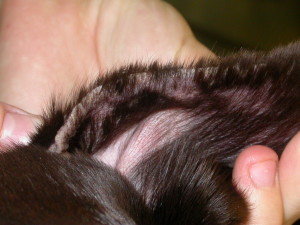
Creepy crawlies in dogs: sarcoptic mange
Canine sarcoptic mange is a non seasonal, highly pruritic and contagious skin disease of dogs caused by infestation with the burrowing mite Sarcoptes scabiei var. canis. The mite is transferable by direct contact or indirectly to other species, including foxes,
The mite is transferable by direct contact or indirectly to other species, including foxes, cats and humans. The entire life cycle lasts for three weeks and is completed on one host; it goes through the typical stages of egg, larva, nymph, and adult. There are no reported age, sex or breed predilections. Clinical signs consist in erythematous maculo-papular eruptions with crusting and alopecia; extensive alopecia, lichenification and hyperpigmentation may be seen in chronic cases. The distribution of the lesions shows usually a typical pattern, with
The distribution of the lesions shows usually a typical pattern, with involvement of the ventral abdomen, the chest, the legs, and especially of the margins of the pinnae (Figure 1) and the elbows (Figure 2). Extreme pruritus, due to a hypersensitivity reaction, is a common feature, with self-trauma and in long term cases demeanour changes.

Differential diagnoses include pruritic skin diseases such as flea allergy dermatitis or other ectoparasitic diseases (cheyletiellosis, otodectic dermatitis), atopic dermatitis, food hypersensitivity and contact dermatitis; the sudden onset and the distribution of the lesions may aid in the differentiation. Although non specific, a positive pinnal-pedal scratch reflex, may be helpful.
Definitive diagnosis is based on the demonstration of the mites and/or their eggs by skin scrapings or faecal flotation of ingested mites and eggs. However, as these mites can be difficult to demonstrate, trial therapy is very important in suspect cases. Alternatively, serological enzyme-linked immunosorbant assay (ELISA) is of aid in the diagnosis

You might also be interested in:
Treatment of canine scabies include topical (amitraz, lyme sulphur dip, fipronil spray) and systemic therapy (moxidectin, and selamectin). Selamectin and moxidectin are licensed to be used twice at four-week intervals; published studies show that these two molecules allow elimination of the mites after two applications 28-30 days apart.
Sarcoptes mites can live in the environment for up to 21 days and environmental treatment has been recommended as part of the overall management to prevent possible re-infestations.

